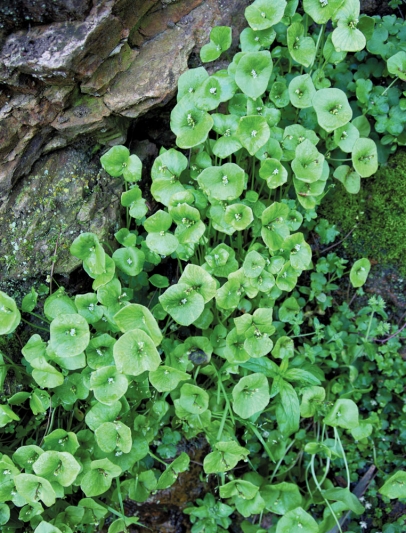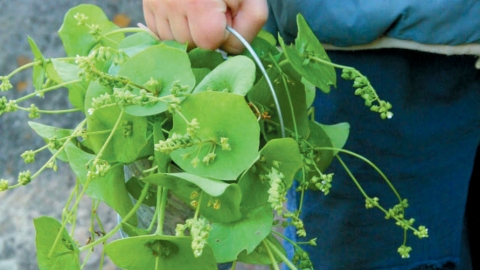Miner’s Lettuce
A WILD MOTHER LODE OF FLAVOR AND NUTRITION
When Northern California turns bright green in early spring, it’s a safe bet that miner’s lettuce is responsible for part of that green carpet, especially in areas that are shady and moist, like my side yard. Every year I look forward to looking out my office window and seeing the wild green spreading reliably from near the house down a slight slope to the orange and grapefruit trees, where the patch is thickest.
The early leaves of miner’s lettuce are somewhat heart shaped, ranging in size from one to two inches, on single stems that grow from a few inches long to up to 12 inches. As the plants continue to grow, each leaf gradually expands and becomes nearly round at the top of each stem. Eventually, a small white flower or flowers will emerge in the center of each leaf.
Sometimes referred to as Indian lettuce, spring beauty or winter purslane, miner’s lettuce is one of those wild plants that looks at first glance like it would be good to eat, and it is. The leaves are tender and slightly succulent with a sweet flavor, lightly tinged with lemon. Its name dates back to the California Gold Rush, when miners realized the abundant green, there for the taking, would help ward off scurvy, the bane of landlubbers and sailors alike who lacked ready access to fresh fruits and vegetables containing vitamin C. So packed with the vitamin is miner’s lettuce that travelers heading back to Europe took seeds with them. By the 19th century, the humble wild “weed” was being widely cultivated across the continent.
Miner’s lettuce, or Claytonia perfoliata, is one of the relatively few edible plants whose origins are in what is now the United States, specifically along the West Coast of the United States, ranging from lower Alaska to San Diego, wherever the conditions for growth are suitable. With only a few exceptions like fennel, other wild edibles that we can gather came from elsewhere, and became naturalized here.
Miner’s lettuce is as easy to grow as you might imagine, but be forewarned: It will spread, which can be a good thing if you are looking to have a bright green, edible open space in spring, but not if you are looking to contain it in a small, rotating potager vegetable garden. I’ve read that birds, especially, like to graze on it, and there is a covey of doves that has decided to make its permanent habitat in and about our property, bunking in various hedges, but they seem to prefer my cultivated vegetables to the wild miner’s lettuce.
Culinarily, miner’s lettuce can be used like any other lettuce, and easily mixes with other greens. I liken it to nasturtium leaves for their color, shape and delicacy. A sturdy ranch or blue cheese dressing will overwhelm the flavor and texture of the leaves, while a light vinaigrette made with walnut oil and Champagne vinegar will highlight them.
If we still made them, and sometimes I long to do so, miner’s lettuce leaves would be an ideal topping for a canapé spread with sweet butter or cream cheese, garnished with a tiny Johnny Jump Up or other small edible flower.
Miner’s lettuce can be used on a sandwich in place of traditional lettuce, used as a beautiful and edible plate liner for main-dish salads like chicken almond or Cobb, or a chopped salad. It can also be used in soups and stews and, because of its nutritional value it makes a good choice, but the characteristic texture and flavor will be diminished.
I suspect you’ll be finding miner’s lettuce on menus throughout the Bay Area this spring as foraged salads and side dishes become increasing popular. As to foraging your own greens, I recommend going with someone who is experienced in gathering wild edibles. Not everything that looks like it should be good to eat, is.






